MKMR303: Research Methodology on Coles and Woolworths Plastic Ban
VerifiedAdded on 2023/06/08
|10
|1741
|252
Report
AI Summary
This report outlines the research methodology employed to investigate the public's reaction to the plastic bag ban implemented by Coles and Woolworths. The research utilizes a descriptive research design and a deductive approach. The sampling technique selected is the Systematic Probability Sampling Technique to avoid bias. Data collection involves both primary and secondary methods, with primary data gathered through surveys using both open-ended and closed-ended questions, and secondary data from various sources. The data analysis will primarily use a primary qualitative method, analyzing the survey responses to draw relevant conclusions. Ethical considerations, including the Data Protection Act (1998), are incorporated to ensure the safety and privacy of respondents. A Gantt chart provides a timeline for the research process. The study aims to understand the causes of customer outrage and provide recommendations for the organizations. The survey questions delve into customer experiences, opinions on the ban, and suggestions for improvement. The research aims to produce reliable and valid findings to inform the organizations' strategies.
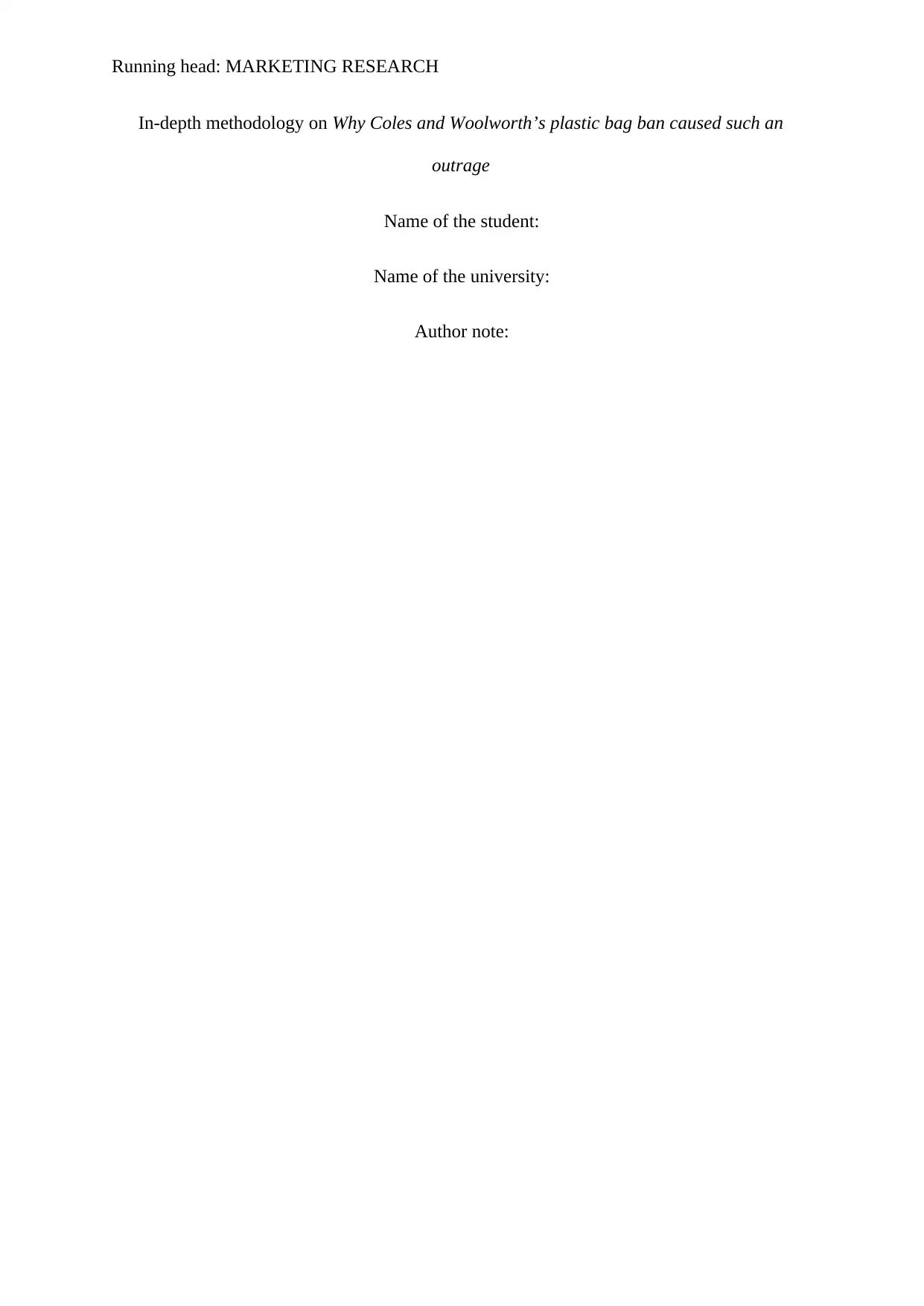
Running head: MARKETING RESEARCH
In-depth methodology on Why Coles and Woolworth’s plastic bag ban caused such an
outrage
Name of the student:
Name of the university:
Author note:
In-depth methodology on Why Coles and Woolworth’s plastic bag ban caused such an
outrage
Name of the student:
Name of the university:
Author note:
Paraphrase This Document
Need a fresh take? Get an instant paraphrase of this document with our AI Paraphraser
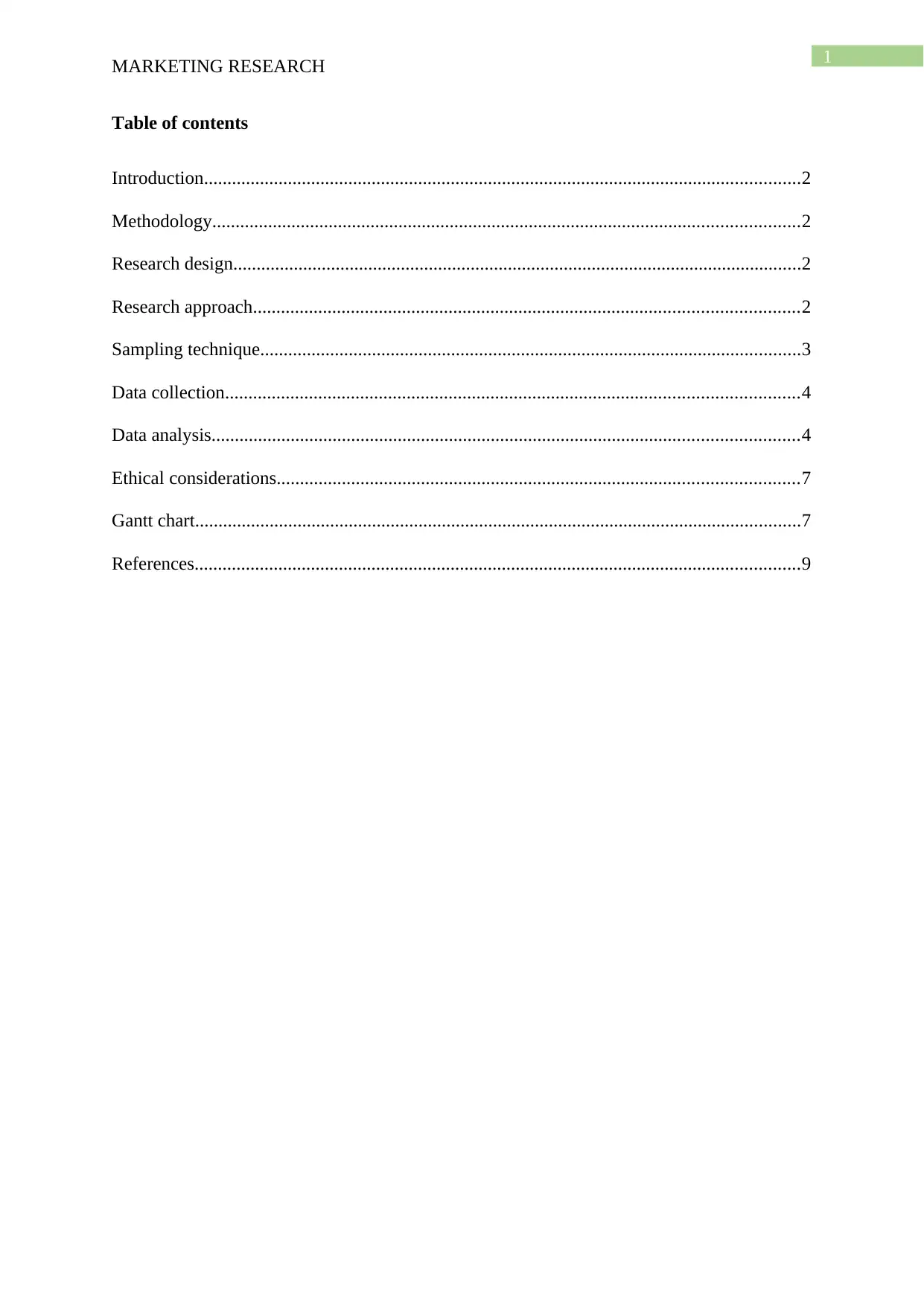
1
MARKETING RESEARCH
Table of contents
Introduction................................................................................................................................2
Methodology..............................................................................................................................2
Research design..........................................................................................................................2
Research approach.....................................................................................................................2
Sampling technique....................................................................................................................3
Data collection...........................................................................................................................4
Data analysis..............................................................................................................................4
Ethical considerations................................................................................................................7
Gantt chart..................................................................................................................................7
References..................................................................................................................................9
MARKETING RESEARCH
Table of contents
Introduction................................................................................................................................2
Methodology..............................................................................................................................2
Research design..........................................................................................................................2
Research approach.....................................................................................................................2
Sampling technique....................................................................................................................3
Data collection...........................................................................................................................4
Data analysis..............................................................................................................................4
Ethical considerations................................................................................................................7
Gantt chart..................................................................................................................................7
References..................................................................................................................................9
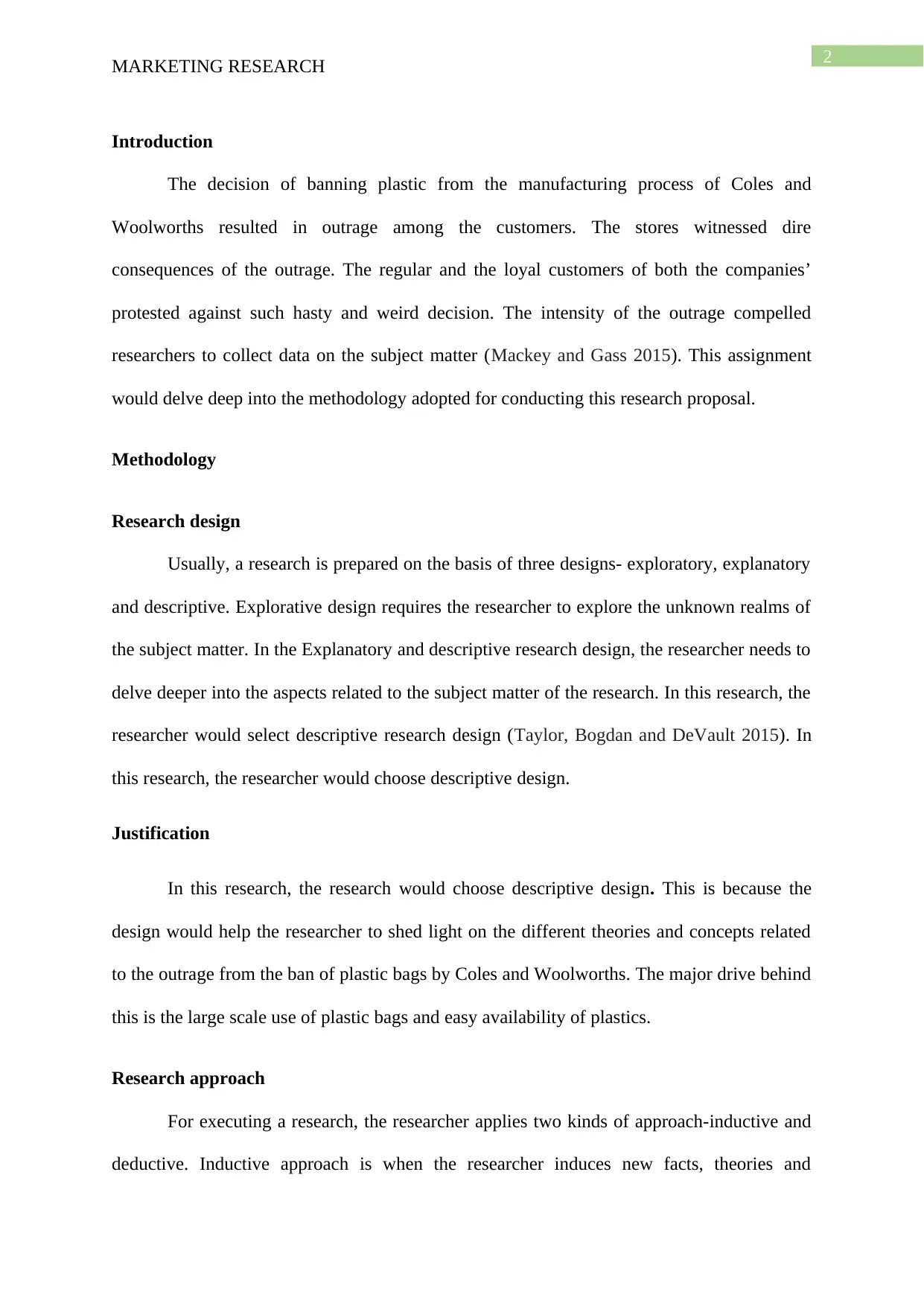
2
MARKETING RESEARCH
Introduction
The decision of banning plastic from the manufacturing process of Coles and
Woolworths resulted in outrage among the customers. The stores witnessed dire
consequences of the outrage. The regular and the loyal customers of both the companies’
protested against such hasty and weird decision. The intensity of the outrage compelled
researchers to collect data on the subject matter (Mackey and Gass 2015). This assignment
would delve deep into the methodology adopted for conducting this research proposal.
Methodology
Research design
Usually, a research is prepared on the basis of three designs- exploratory, explanatory
and descriptive. Explorative design requires the researcher to explore the unknown realms of
the subject matter. In the Explanatory and descriptive research design, the researcher needs to
delve deeper into the aspects related to the subject matter of the research. In this research, the
researcher would select descriptive research design (Taylor, Bogdan and DeVault 2015). In
this research, the researcher would choose descriptive design.
Justification
In this research, the research would choose descriptive design. This is because the
design would help the researcher to shed light on the different theories and concepts related
to the outrage from the ban of plastic bags by Coles and Woolworths. The major drive behind
this is the large scale use of plastic bags and easy availability of plastics.
Research approach
For executing a research, the researcher applies two kinds of approach-inductive and
deductive. Inductive approach is when the researcher induces new facts, theories and
MARKETING RESEARCH
Introduction
The decision of banning plastic from the manufacturing process of Coles and
Woolworths resulted in outrage among the customers. The stores witnessed dire
consequences of the outrage. The regular and the loyal customers of both the companies’
protested against such hasty and weird decision. The intensity of the outrage compelled
researchers to collect data on the subject matter (Mackey and Gass 2015). This assignment
would delve deep into the methodology adopted for conducting this research proposal.
Methodology
Research design
Usually, a research is prepared on the basis of three designs- exploratory, explanatory
and descriptive. Explorative design requires the researcher to explore the unknown realms of
the subject matter. In the Explanatory and descriptive research design, the researcher needs to
delve deeper into the aspects related to the subject matter of the research. In this research, the
researcher would select descriptive research design (Taylor, Bogdan and DeVault 2015). In
this research, the researcher would choose descriptive design.
Justification
In this research, the research would choose descriptive design. This is because the
design would help the researcher to shed light on the different theories and concepts related
to the outrage from the ban of plastic bags by Coles and Woolworths. The major drive behind
this is the large scale use of plastic bags and easy availability of plastics.
Research approach
For executing a research, the researcher applies two kinds of approach-inductive and
deductive. Inductive approach is when the researcher induces new facts, theories and
⊘ This is a preview!⊘
Do you want full access?
Subscribe today to unlock all pages.

Trusted by 1+ million students worldwide
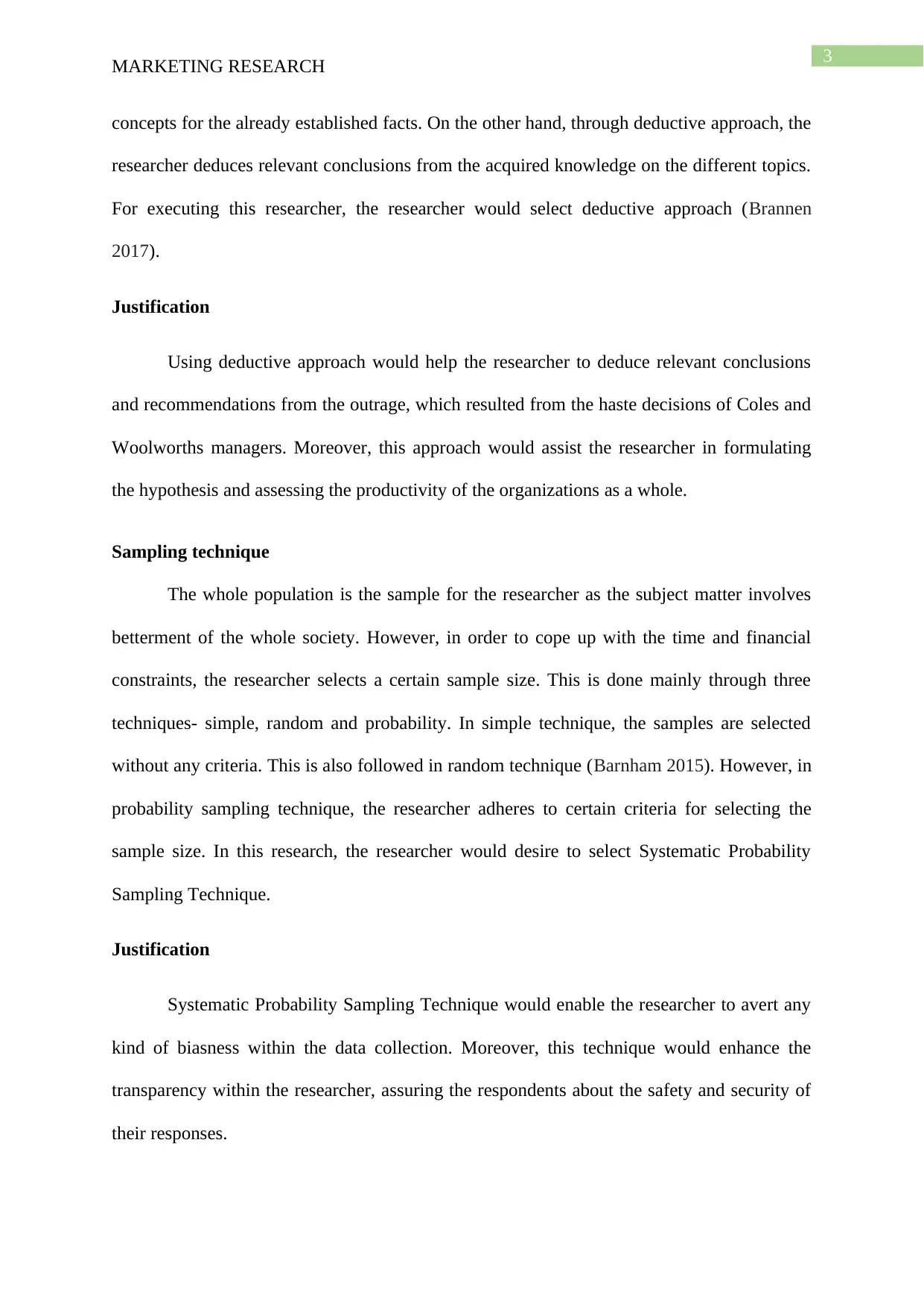
3
MARKETING RESEARCH
concepts for the already established facts. On the other hand, through deductive approach, the
researcher deduces relevant conclusions from the acquired knowledge on the different topics.
For executing this researcher, the researcher would select deductive approach (Brannen
2017).
Justification
Using deductive approach would help the researcher to deduce relevant conclusions
and recommendations from the outrage, which resulted from the haste decisions of Coles and
Woolworths managers. Moreover, this approach would assist the researcher in formulating
the hypothesis and assessing the productivity of the organizations as a whole.
Sampling technique
The whole population is the sample for the researcher as the subject matter involves
betterment of the whole society. However, in order to cope up with the time and financial
constraints, the researcher selects a certain sample size. This is done mainly through three
techniques- simple, random and probability. In simple technique, the samples are selected
without any criteria. This is also followed in random technique (Barnham 2015). However, in
probability sampling technique, the researcher adheres to certain criteria for selecting the
sample size. In this research, the researcher would desire to select Systematic Probability
Sampling Technique.
Justification
Systematic Probability Sampling Technique would enable the researcher to avert any
kind of biasness within the data collection. Moreover, this technique would enhance the
transparency within the researcher, assuring the respondents about the safety and security of
their responses.
MARKETING RESEARCH
concepts for the already established facts. On the other hand, through deductive approach, the
researcher deduces relevant conclusions from the acquired knowledge on the different topics.
For executing this researcher, the researcher would select deductive approach (Brannen
2017).
Justification
Using deductive approach would help the researcher to deduce relevant conclusions
and recommendations from the outrage, which resulted from the haste decisions of Coles and
Woolworths managers. Moreover, this approach would assist the researcher in formulating
the hypothesis and assessing the productivity of the organizations as a whole.
Sampling technique
The whole population is the sample for the researcher as the subject matter involves
betterment of the whole society. However, in order to cope up with the time and financial
constraints, the researcher selects a certain sample size. This is done mainly through three
techniques- simple, random and probability. In simple technique, the samples are selected
without any criteria. This is also followed in random technique (Barnham 2015). However, in
probability sampling technique, the researcher adheres to certain criteria for selecting the
sample size. In this research, the researcher would desire to select Systematic Probability
Sampling Technique.
Justification
Systematic Probability Sampling Technique would enable the researcher to avert any
kind of biasness within the data collection. Moreover, this technique would enhance the
transparency within the researcher, assuring the respondents about the safety and security of
their responses.
Paraphrase This Document
Need a fresh take? Get an instant paraphrase of this document with our AI Paraphraser
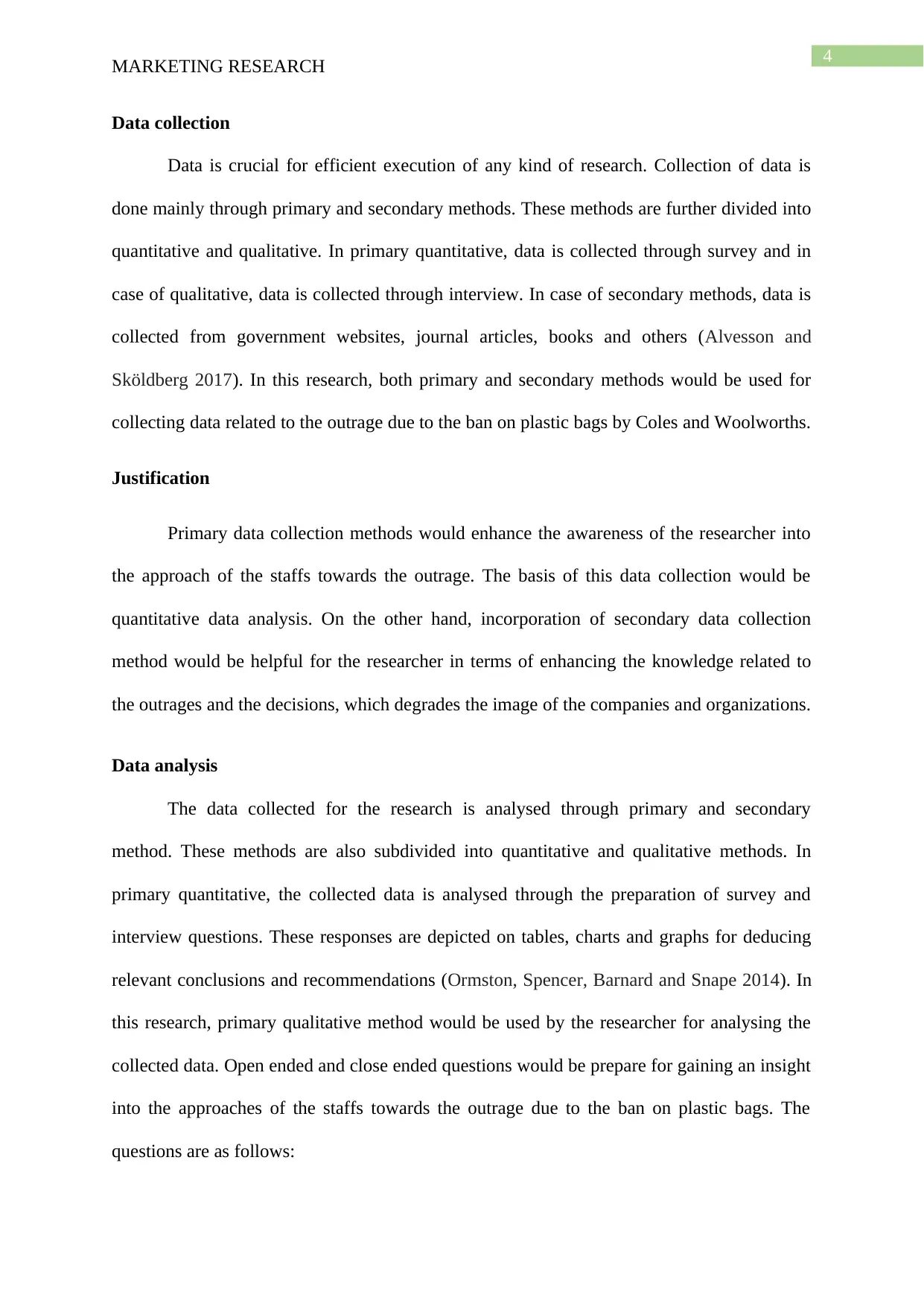
4
MARKETING RESEARCH
Data collection
Data is crucial for efficient execution of any kind of research. Collection of data is
done mainly through primary and secondary methods. These methods are further divided into
quantitative and qualitative. In primary quantitative, data is collected through survey and in
case of qualitative, data is collected through interview. In case of secondary methods, data is
collected from government websites, journal articles, books and others (Alvesson and
Sköldberg 2017). In this research, both primary and secondary methods would be used for
collecting data related to the outrage due to the ban on plastic bags by Coles and Woolworths.
Justification
Primary data collection methods would enhance the awareness of the researcher into
the approach of the staffs towards the outrage. The basis of this data collection would be
quantitative data analysis. On the other hand, incorporation of secondary data collection
method would be helpful for the researcher in terms of enhancing the knowledge related to
the outrages and the decisions, which degrades the image of the companies and organizations.
Data analysis
The data collected for the research is analysed through primary and secondary
method. These methods are also subdivided into quantitative and qualitative methods. In
primary quantitative, the collected data is analysed through the preparation of survey and
interview questions. These responses are depicted on tables, charts and graphs for deducing
relevant conclusions and recommendations (Ormston, Spencer, Barnard and Snape 2014). In
this research, primary qualitative method would be used by the researcher for analysing the
collected data. Open ended and close ended questions would be prepare for gaining an insight
into the approaches of the staffs towards the outrage due to the ban on plastic bags. The
questions are as follows:
MARKETING RESEARCH
Data collection
Data is crucial for efficient execution of any kind of research. Collection of data is
done mainly through primary and secondary methods. These methods are further divided into
quantitative and qualitative. In primary quantitative, data is collected through survey and in
case of qualitative, data is collected through interview. In case of secondary methods, data is
collected from government websites, journal articles, books and others (Alvesson and
Sköldberg 2017). In this research, both primary and secondary methods would be used for
collecting data related to the outrage due to the ban on plastic bags by Coles and Woolworths.
Justification
Primary data collection methods would enhance the awareness of the researcher into
the approach of the staffs towards the outrage. The basis of this data collection would be
quantitative data analysis. On the other hand, incorporation of secondary data collection
method would be helpful for the researcher in terms of enhancing the knowledge related to
the outrages and the decisions, which degrades the image of the companies and organizations.
Data analysis
The data collected for the research is analysed through primary and secondary
method. These methods are also subdivided into quantitative and qualitative methods. In
primary quantitative, the collected data is analysed through the preparation of survey and
interview questions. These responses are depicted on tables, charts and graphs for deducing
relevant conclusions and recommendations (Ormston, Spencer, Barnard and Snape 2014). In
this research, primary qualitative method would be used by the researcher for analysing the
collected data. Open ended and close ended questions would be prepare for gaining an insight
into the approaches of the staffs towards the outrage due to the ban on plastic bags. The
questions are as follows:
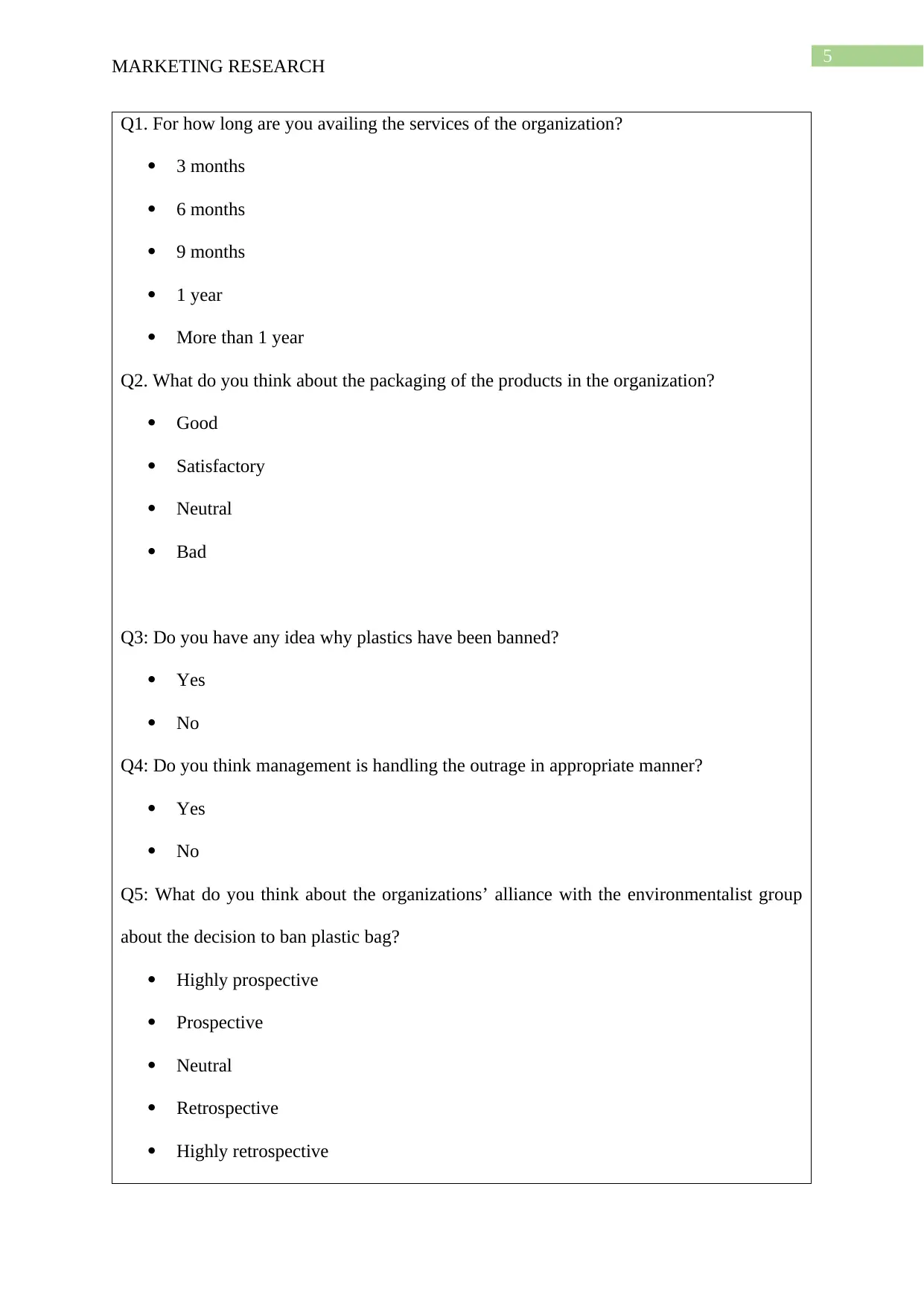
5
MARKETING RESEARCH
Q1. For how long are you availing the services of the organization?
3 months
6 months
9 months
1 year
More than 1 year
Q2. What do you think about the packaging of the products in the organization?
Good
Satisfactory
Neutral
Bad
Q3: Do you have any idea why plastics have been banned?
Yes
No
Q4: Do you think management is handling the outrage in appropriate manner?
Yes
No
Q5: What do you think about the organizations’ alliance with the environmentalist group
about the decision to ban plastic bag?
Highly prospective
Prospective
Neutral
Retrospective
Highly retrospective
MARKETING RESEARCH
Q1. For how long are you availing the services of the organization?
3 months
6 months
9 months
1 year
More than 1 year
Q2. What do you think about the packaging of the products in the organization?
Good
Satisfactory
Neutral
Bad
Q3: Do you have any idea why plastics have been banned?
Yes
No
Q4: Do you think management is handling the outrage in appropriate manner?
Yes
No
Q5: What do you think about the organizations’ alliance with the environmentalist group
about the decision to ban plastic bag?
Highly prospective
Prospective
Neutral
Retrospective
Highly retrospective
⊘ This is a preview!⊘
Do you want full access?
Subscribe today to unlock all pages.

Trusted by 1+ million students worldwide
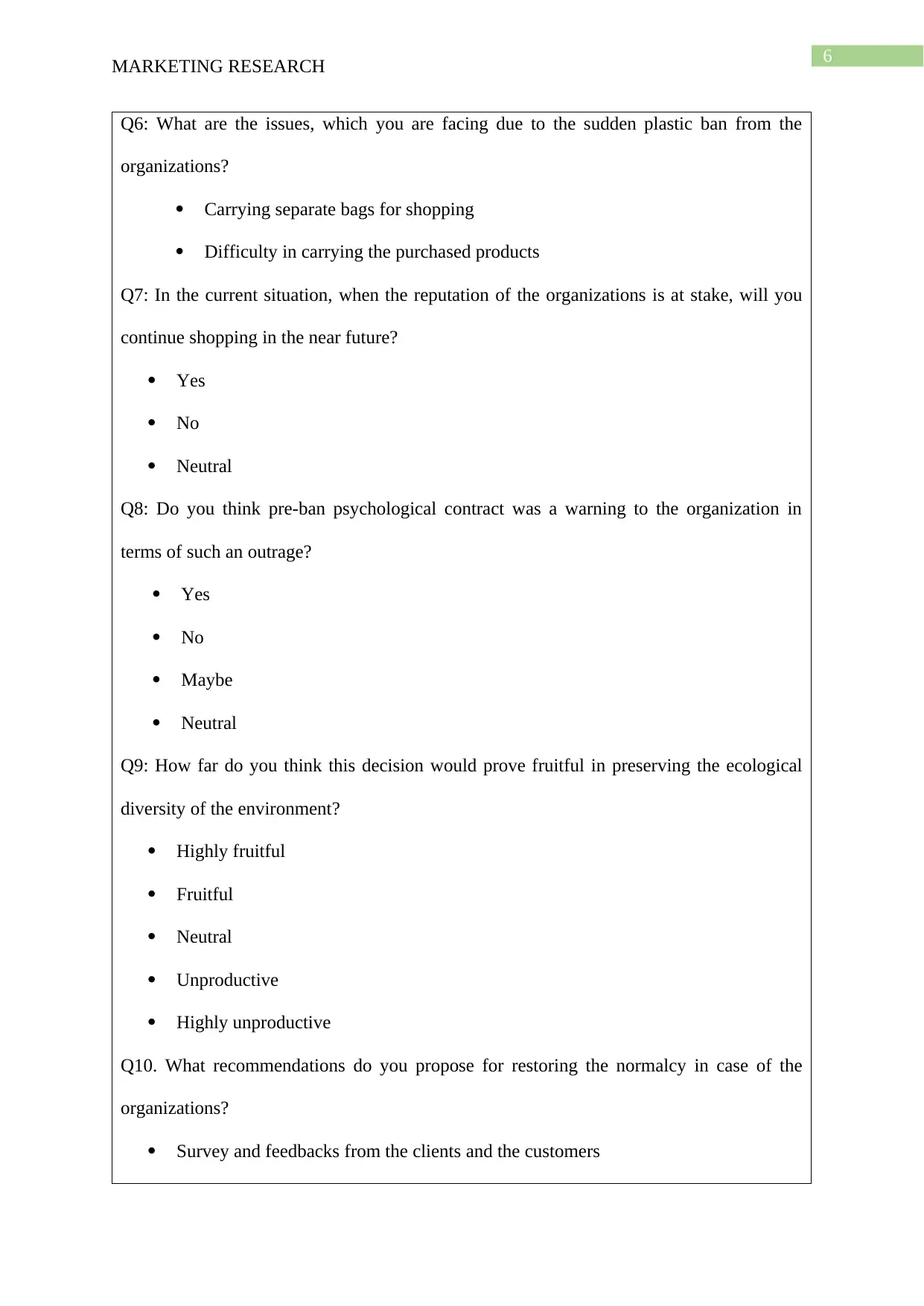
6
MARKETING RESEARCH
Q6: What are the issues, which you are facing due to the sudden plastic ban from the
organizations?
Carrying separate bags for shopping
Difficulty in carrying the purchased products
Q7: In the current situation, when the reputation of the organizations is at stake, will you
continue shopping in the near future?
Yes
No
Neutral
Q8: Do you think pre-ban psychological contract was a warning to the organization in
terms of such an outrage?
Yes
No
Maybe
Neutral
Q9: How far do you think this decision would prove fruitful in preserving the ecological
diversity of the environment?
Highly fruitful
Fruitful
Neutral
Unproductive
Highly unproductive
Q10. What recommendations do you propose for restoring the normalcy in case of the
organizations?
Survey and feedbacks from the clients and the customers
MARKETING RESEARCH
Q6: What are the issues, which you are facing due to the sudden plastic ban from the
organizations?
Carrying separate bags for shopping
Difficulty in carrying the purchased products
Q7: In the current situation, when the reputation of the organizations is at stake, will you
continue shopping in the near future?
Yes
No
Neutral
Q8: Do you think pre-ban psychological contract was a warning to the organization in
terms of such an outrage?
Yes
No
Maybe
Neutral
Q9: How far do you think this decision would prove fruitful in preserving the ecological
diversity of the environment?
Highly fruitful
Fruitful
Neutral
Unproductive
Highly unproductive
Q10. What recommendations do you propose for restoring the normalcy in case of the
organizations?
Survey and feedbacks from the clients and the customers
Paraphrase This Document
Need a fresh take? Get an instant paraphrase of this document with our AI Paraphraser
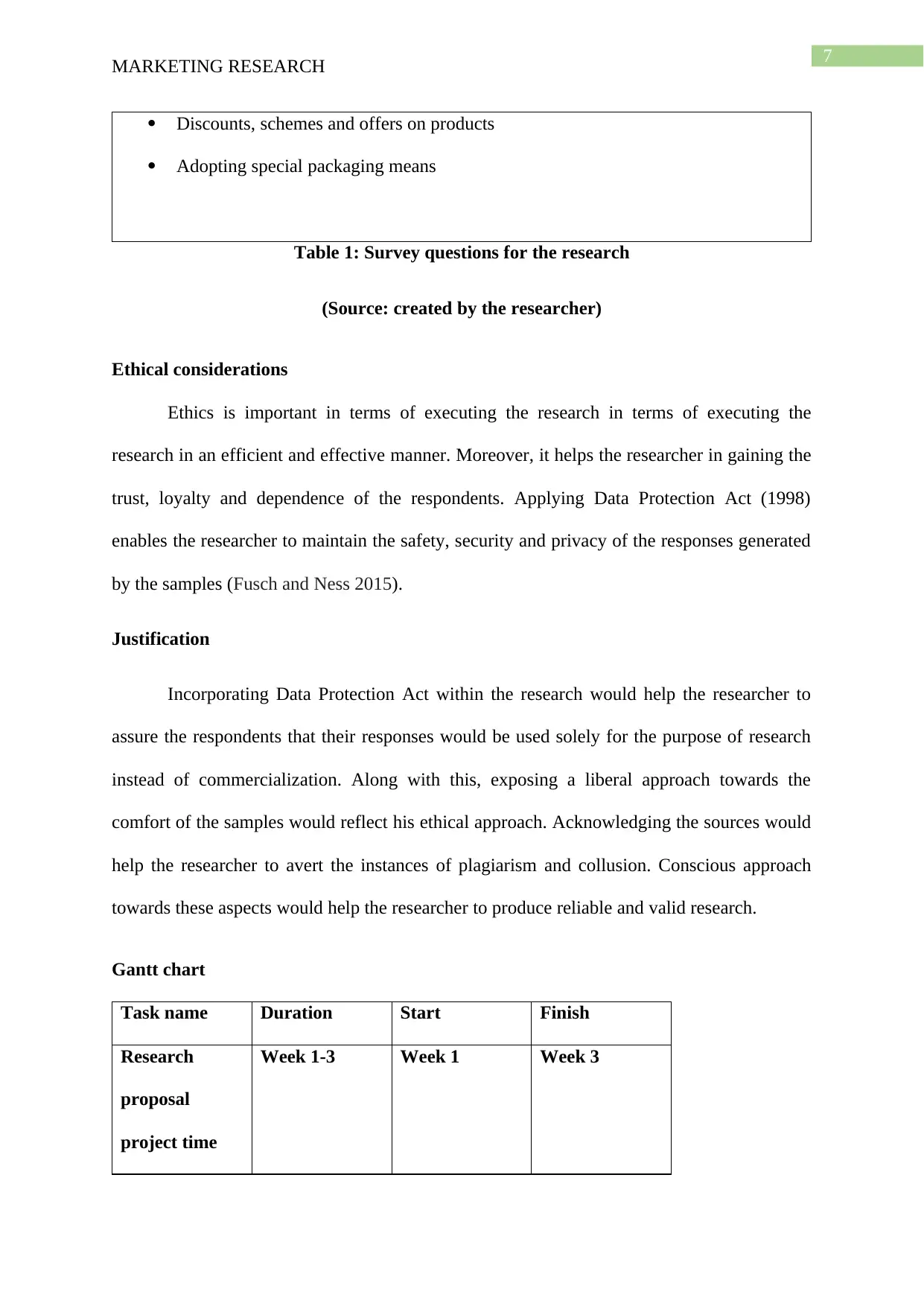
7
MARKETING RESEARCH
Discounts, schemes and offers on products
Adopting special packaging means
Table 1: Survey questions for the research
(Source: created by the researcher)
Ethical considerations
Ethics is important in terms of executing the research in terms of executing the
research in an efficient and effective manner. Moreover, it helps the researcher in gaining the
trust, loyalty and dependence of the respondents. Applying Data Protection Act (1998)
enables the researcher to maintain the safety, security and privacy of the responses generated
by the samples (Fusch and Ness 2015).
Justification
Incorporating Data Protection Act within the research would help the researcher to
assure the respondents that their responses would be used solely for the purpose of research
instead of commercialization. Along with this, exposing a liberal approach towards the
comfort of the samples would reflect his ethical approach. Acknowledging the sources would
help the researcher to avert the instances of plagiarism and collusion. Conscious approach
towards these aspects would help the researcher to produce reliable and valid research.
Gantt chart
Task name Duration Start Finish
Research
proposal
project time
Week 1-3 Week 1 Week 3
MARKETING RESEARCH
Discounts, schemes and offers on products
Adopting special packaging means
Table 1: Survey questions for the research
(Source: created by the researcher)
Ethical considerations
Ethics is important in terms of executing the research in terms of executing the
research in an efficient and effective manner. Moreover, it helps the researcher in gaining the
trust, loyalty and dependence of the respondents. Applying Data Protection Act (1998)
enables the researcher to maintain the safety, security and privacy of the responses generated
by the samples (Fusch and Ness 2015).
Justification
Incorporating Data Protection Act within the research would help the researcher to
assure the respondents that their responses would be used solely for the purpose of research
instead of commercialization. Along with this, exposing a liberal approach towards the
comfort of the samples would reflect his ethical approach. Acknowledging the sources would
help the researcher to avert the instances of plagiarism and collusion. Conscious approach
towards these aspects would help the researcher to produce reliable and valid research.
Gantt chart
Task name Duration Start Finish
Research
proposal
project time
Week 1-3 Week 1 Week 3
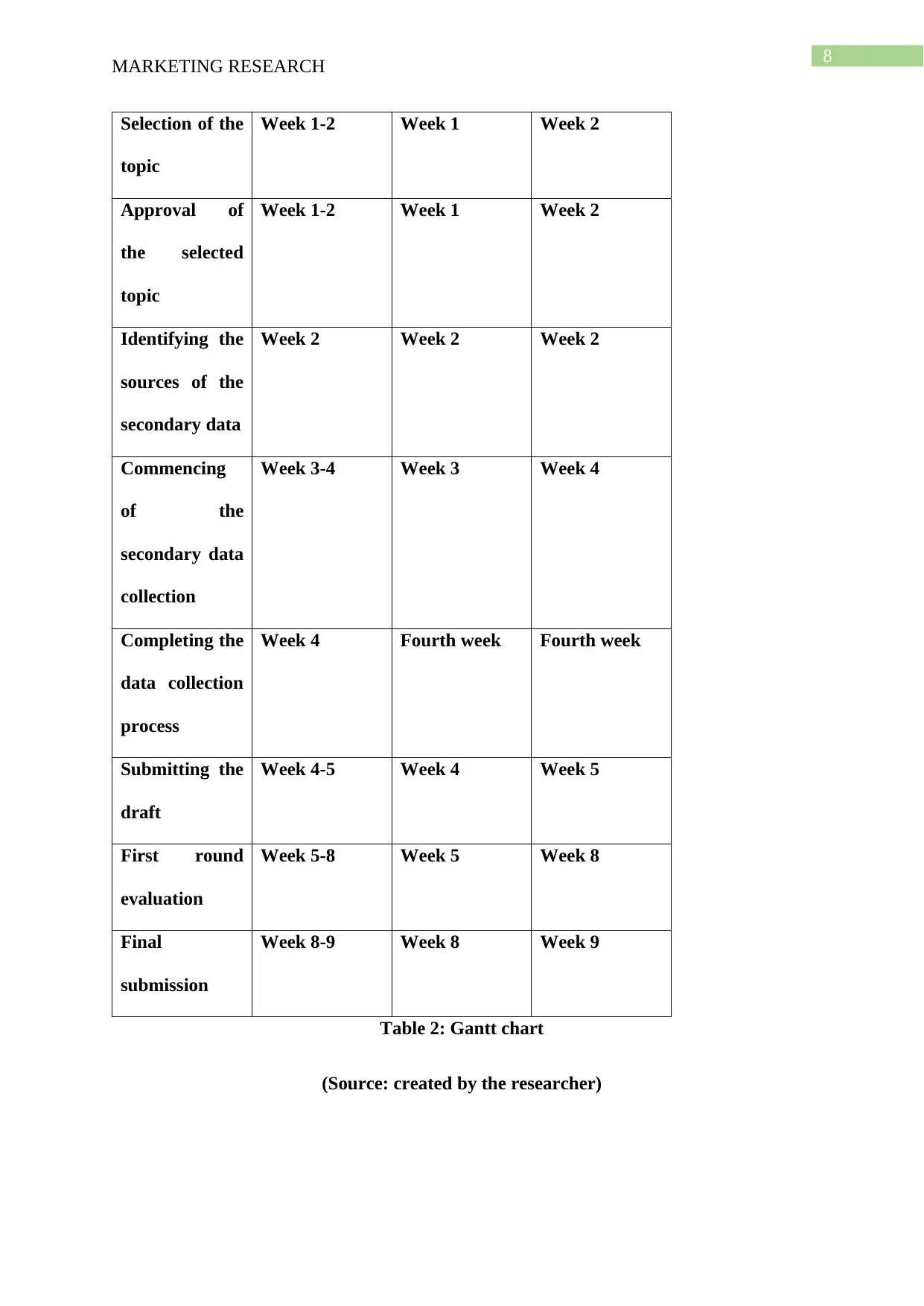
8
MARKETING RESEARCH
Selection of the
topic
Week 1-2 Week 1 Week 2
Approval of
the selected
topic
Week 1-2 Week 1 Week 2
Identifying the
sources of the
secondary data
Week 2 Week 2 Week 2
Commencing
of the
secondary data
collection
Week 3-4 Week 3 Week 4
Completing the
data collection
process
Week 4 Fourth week Fourth week
Submitting the
draft
Week 4-5 Week 4 Week 5
First round
evaluation
Week 5-8 Week 5 Week 8
Final
submission
Week 8-9 Week 8 Week 9
Table 2: Gantt chart
(Source: created by the researcher)
MARKETING RESEARCH
Selection of the
topic
Week 1-2 Week 1 Week 2
Approval of
the selected
topic
Week 1-2 Week 1 Week 2
Identifying the
sources of the
secondary data
Week 2 Week 2 Week 2
Commencing
of the
secondary data
collection
Week 3-4 Week 3 Week 4
Completing the
data collection
process
Week 4 Fourth week Fourth week
Submitting the
draft
Week 4-5 Week 4 Week 5
First round
evaluation
Week 5-8 Week 5 Week 8
Final
submission
Week 8-9 Week 8 Week 9
Table 2: Gantt chart
(Source: created by the researcher)
⊘ This is a preview!⊘
Do you want full access?
Subscribe today to unlock all pages.

Trusted by 1+ million students worldwide
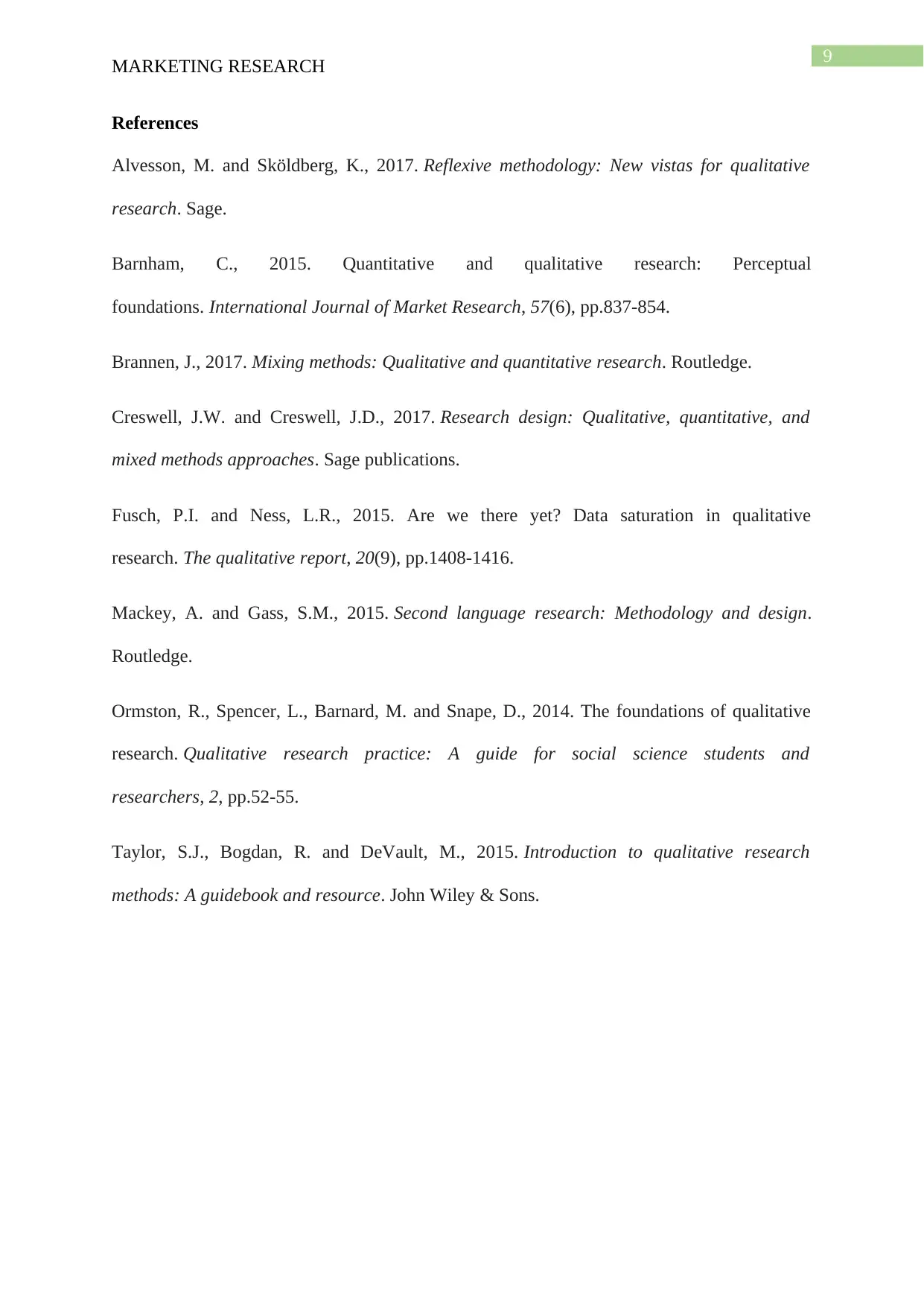
9
MARKETING RESEARCH
References
Alvesson, M. and Sköldberg, K., 2017. Reflexive methodology: New vistas for qualitative
research. Sage.
Barnham, C., 2015. Quantitative and qualitative research: Perceptual
foundations. International Journal of Market Research, 57(6), pp.837-854.
Brannen, J., 2017. Mixing methods: Qualitative and quantitative research. Routledge.
Creswell, J.W. and Creswell, J.D., 2017. Research design: Qualitative, quantitative, and
mixed methods approaches. Sage publications.
Fusch, P.I. and Ness, L.R., 2015. Are we there yet? Data saturation in qualitative
research. The qualitative report, 20(9), pp.1408-1416.
Mackey, A. and Gass, S.M., 2015. Second language research: Methodology and design.
Routledge.
Ormston, R., Spencer, L., Barnard, M. and Snape, D., 2014. The foundations of qualitative
research. Qualitative research practice: A guide for social science students and
researchers, 2, pp.52-55.
Taylor, S.J., Bogdan, R. and DeVault, M., 2015. Introduction to qualitative research
methods: A guidebook and resource. John Wiley & Sons.
MARKETING RESEARCH
References
Alvesson, M. and Sköldberg, K., 2017. Reflexive methodology: New vistas for qualitative
research. Sage.
Barnham, C., 2015. Quantitative and qualitative research: Perceptual
foundations. International Journal of Market Research, 57(6), pp.837-854.
Brannen, J., 2017. Mixing methods: Qualitative and quantitative research. Routledge.
Creswell, J.W. and Creswell, J.D., 2017. Research design: Qualitative, quantitative, and
mixed methods approaches. Sage publications.
Fusch, P.I. and Ness, L.R., 2015. Are we there yet? Data saturation in qualitative
research. The qualitative report, 20(9), pp.1408-1416.
Mackey, A. and Gass, S.M., 2015. Second language research: Methodology and design.
Routledge.
Ormston, R., Spencer, L., Barnard, M. and Snape, D., 2014. The foundations of qualitative
research. Qualitative research practice: A guide for social science students and
researchers, 2, pp.52-55.
Taylor, S.J., Bogdan, R. and DeVault, M., 2015. Introduction to qualitative research
methods: A guidebook and resource. John Wiley & Sons.
1 out of 10
Related Documents
Your All-in-One AI-Powered Toolkit for Academic Success.
+13062052269
info@desklib.com
Available 24*7 on WhatsApp / Email
![[object Object]](/_next/static/media/star-bottom.7253800d.svg)
Unlock your academic potential
Copyright © 2020–2025 A2Z Services. All Rights Reserved. Developed and managed by ZUCOL.





